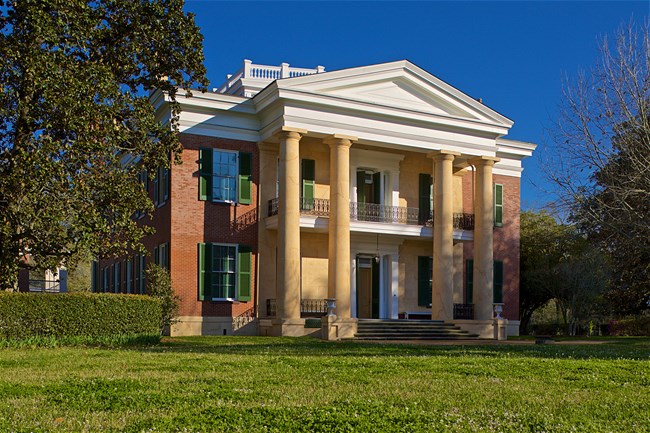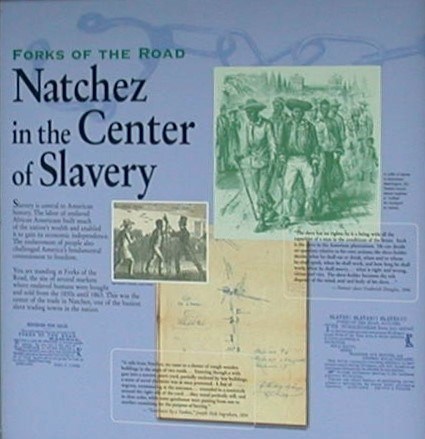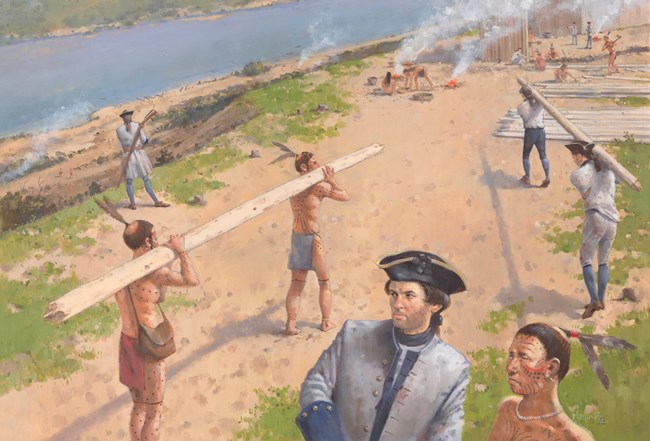
NPS photo, Mark Coffey, photographer. Melrose The great estate known as Melrose was not a working plantation but a suburban residence for wealthy lawyer and cotton planter, his family, and the enslaved people who lived and worked there. The estate features a main dwelling house, designed in the popular Greek Revival style, along with many of the original outbuildings, including former quarters for enslaved people, kitchen and dairy dependencies, carriage house, stable and smokehouse. The main house rests in a romantic, mid-19th century landscape, with lawns, meadows, ponds, and formal gardens. Jacob Byers was the architect for the estate and he used master Irish brick masons and skilled enslaved laborers to construct the main house and outbuildings. When completed, the house was described as having the best brick work on a house in the State of Mississippi, some went so far as to describe it as the best in the country. Indeed, Melrose, a National Historic Landmarks, has been described as one of the great houses of the American South. In addition to the architecture and the collection of outbuildings, the estate is also significant for the important collection of original fine and decorative arts found in the mansion. 
NPS photo William Johnson House The William Johnson House provides an opportunity to connect visitors with the unique story of a free Black American and his family during the antebellum period. This interpretation is supported by the personal papers and published diary of William Johnson, as well as information collected in oral histories and artifacts from his descendants. Born into slavery in 1809, Johnson rose from these limited beginnings to become a well-respected business owner and community figure. Johnson owned three barbershops, which provided his main source of income, but he constantly explored different avenues to increase his wealth. In addition to his home and rural property, Johnson also claimed ownership of several enslaved people who labored in his home, barbershops, and farms. Johnson's eventual death was due to a land dispute with an allegedly White man, Baylor Winn, who ambused Johnson near his farm south of Natchez and shot him as he was returning to town. Winn was able to avoid persecution despite Johnson naming him the murderer on his deathbed because Mississippi law barred the use of testimony from non-enslaved people against a White man. 
NPS Acquired by Natchez National Historical Park in 2020, the Natchez Visitor Center (NVC) is located just off Highway 84 and the Mississippi River Bridge, which takes those travelling west into Louisiana. The 25,000 sq. ft. building also serves as the Southern Terminus Visitor Center for the Natchez Trace Parkway and as a welcome center for the State of Mississippi. The NVC hosts permanent exhibits and displays, a temporary exhibit space, a theater, gift store, offices and booths to purchase tickets to various regional attractions. Friendly and knowlegeable staff are available to assist visitors with all of their travel plans. The building has a large parking lot area that provides nearby access to Fort Rosalie and the William Johnson house. The NVC also provides a covered and accessible walkway providing panoramic views of the Mississippi River. 
NPS photo In 2020, the Natchez National Historical Park, in cooperation with and the support of the City of Natchez, the National Park Foundation, and the Friends of the Forks of the Road, began the acquisition the development of a long-range interpretive plan for this national site of conscience. In the mid-19th century, Natchez, Mississippi was the epicenter of American capitalism and American slavery. The invention of the cotton gin, the availability of vast stretches of lands recently vacated by the forced removal of the Chickasaw Indians, and the arrival of steamboats plying the Mississippi River, made Natchez the ideal location for the creation of an economy centered around slave labor-generated cotton. Between 1832 and 1863, Natchez housed the second busiest slave trading market in the Deep South at Forks of the Road, the intersection of what is today, Liberty Road and D'Evereux Drive, one mile east of downtown Natchez. Prior to the establishment of the market at the Forks of the Road, slave trading was a common sight on almost every street corner in Natchez. In 1832, however, the fear of cholera forced the town council to order the slave traders outside the city limits. Over the next thirty years, tens of thousands of enslaved men, women, and children were transported from Virginia, Maryland, Kentucky, and the Carolinas to the slave market at Natchez. Numerous travelers through the region visited the slave market and recorded their impressions of the human trafficking site. In the fall of 1863, members of the 12th Wisconsin Infantry were joined in their efforts to tear down the slave "pens" at the Forks of the Road by members of the newly created 58th United States Colored Troops. In a January, 1864 letter to the Milwaukee Sentinel, a member of the Wisconsin unit noted the following: Our first quarters were in a long range of barracks used for a number of years as slave pens. Very many of the men composing the regiment had been sold in them; brought from Kentucky, Tennessee, Virginia and other slave States, in large gangs ironed, they were placed in these dungeons until a sale could be effected. These buildings were situated in outskirts of the city and owned by an Irishman, the worst secessionists in the whole country. As the position was very much exposed, we were ordered to construct barracks within the fortifications and to tear down these slave pens to obtain lumber to build them. This order was received just at evening and was hailed with the wildest enthusiasm by these men who had been chained, gagged and whipped, and suffered tortures unutterable within these same walls, and through that long night they worked with a terrible earnestness and the morning saw the slave pens of Natchez leveled to the ground, never, it is hoped to be again reconstructed. During this work many a thrilling remimbrence [sic] was recalled of the cruelty of traders, of sad partings of husband and wife, of inhuman fathers selling their own children, and a thousand other incidents illustrating the detestable state of society at the South. Presently, visitors to the site will find a series of exhibit panels with information about the domestic slave trade and Natchez as the center of American slavery in the 19th century, as well as an artistic depiction of slave manacles and chains in a concrete form. 
The Fort Rosalie site provides the most direct access to interpreting the international context of Natchez's development as the earliest European settlement on the lower Mississippi River. Founded in 1716 by the French, the fort served as the primary French stronghold and trading post with the local Natchez Indians. French settlements and tobacco plantations were established in Natchez with the fort serving as the local seat of colonial government. In 1729, growing tension between the French and the Natchez erupted in violence on Nov. 28, when the local tribe rose up, seized the fort, and massacred most of the French settlers, killing between 229 and 285 colonists. The French retaliated and engaged in a war of persecution and extermination of the Natchez people. Fort Rosalie was later occupied by the English, Spanish and Americans. Archaeological work at the site has provided valuable data on the early colonial settlement of the region. The bluff at the Fort Rosalie site provides expansive views both upstream and downstream of the river, clearly reflecting the strategic importance of the site to the European powers that battled for control of the lower Mississippi River Valley. |
Last updated: February 19, 2025
